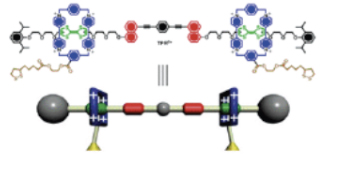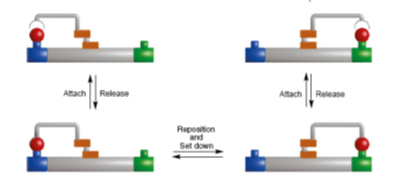Introduction:
According to the Merriam-Webster English Dictionary a machine is “An assemblage of parts that transmits forces, motion, or energy from one to another in a predetermined manner”. But this deals with the macroscopic part of the world. But in view of the chemists a machine is “An assemblage of atoms and molecules that transmits forces, motion, or energy from one to another in a predetermined manner”. Molecular machines are the machines which work at the molecular level. More precisely, when molecular changes occur responding to the external stimuli or perturbation. Some of the smallest, most useful machines known to science are the biological molecules that keep living things living. The nature’s strategies are From Atoms to Molecules to Supramolecular Aggregates to Biomolecular Machines (figure 1). In biological systems like the proteins myosin energies the contraction and relaxation of muscles. Cellular cargo around the cell is dragged by Kinesin. Different enzymatic activities like, unwind, rewind, and wrapping, and molecular motor used by bacteria to rotate their whip-like flagella up to 100,000 times per minute, propelling them forward. These all machines produce their motion from the chemical energy released by bond braking or making. These systems are very efficient at their jobs. Researchers now are confident enough to develop the similar efficient machines for versatile application in our society. Although mimicking biological systems demands lot attention and high-end sophistic approach, people have been successful to develop few of them.

Figure 1. (image taken from reference 1).
Idea from Biology:
We can acquire knowledge from nature’s biological systems, as 1) biological machines are soft and flexible, 2) biological systems operate at ambient pressure and temperatures, 3) biological motors utilize chemical energy, in the form of non-covalent/covalent-bond breaking/formation or concentration gradients, 4) bio-machines function in solution, 5) bio-motors and other machines utilize spatial orientation which serve to restrict most of the degrees of freedom of the machine components and/or the substrate(s) they act upon. The molecular machine and the substrate(s) acting together remain kinetically allied during the function of the machine, 6) most of the time non-covalent interactions (intramolecular and intermolecular) rule the biological machines.
Bio-mimetics and Techno-mimetics:
There are two different approach towards designing molecular machines. In the first approach we can use an existing model which is already established in biology and apply those concepts for designing the artificial molecular machines. A latent benefit of the biomimetic approach is that such designs are visibly functional machines and can operate at the nanoscale with the definite limitations as nature has. Nature developed lot of bio-machines only with the help of 20 different building blocks (amino acids), ambient pH, concentration, pressures and temperatures and moreover water as the functioning medium. However, a major issue in pursuing this strategy is that we don’t have clear mechanistic views, biological machines are very complicated and it becomes tough job to deconvolute the inherent reasons behind the working dynamics of individual parts of the machines. How and why the muscles work with proper order of confinement? How the parameters like, spatial arrangement, hydrogen bonding, and/or solvation changes are necessary to continue work in progress; and which only occur as a consequence of other intrinsically required intramolecular rearrangements? Applying fundamental principles deduced from small-scale physics and bio-machines would be more interesting in this manner. The second approach can be to change the scale of macroscopic world to microscopic world. We can follow the Drexler’s proposal, which describes that “a device able to guide chemical reactions by positioning reactive molecules with atomic precision” that means the molecular assembly can act as a whole a machine and this concept spawn the inspiration behind “nano-cars”, “molecular wheelbarrows”, “molecular elevators”, “molecular pistons” etc. This approach can be advantageous because engineering concepts work behind such machines and mechanisms are well understood in terms of their macroscopic counterparts; but it also includes some drawbacks which unveil that these machines are inappropriate for the molecular world.
Latest research on artificial molecular machines enforces us to think that such molecular devices are achievable in reality. Researchers have developed power-driven, (heat energy, electrical energy, chemical reactions, or light.) molecular motors, shuttles, elevators, walkers etc. (figure 2). These developments are edging toward future applications that could assort from molecular electronics to artificial muscles. The work still deals with the fundamental and no one really knows what to do with the machines or how they’ll be useful. Prof. Stoddart and his co-workers got the Nobel prize in the year 2016 for their contribution in this field.

Figure 2. (taken from reference 3)
Simple Machines:
After the invention of the switchable molecular shuttle by Stoddart’s (figure 3), the field is geared-up and many chemists have developed variety of molecular switching molecular systems based on “on”/“off” tasks with synthetic mechanically interlocked molecules. Generally, people use a catenane and/or rotaxane switches which act as bits in molecular electronics and also used for fluorescence switching, chiroptical switching, controlled release delivery systems, for switchable catalysts etc. These are the simple machine for more complex task, molecular system will also be more complicated and the integration of the dynamics of the individual parts of the molecular machine have to organize in such a way that it works more than the simple one.

Figure 3. Stoddart’s simple molecular machine based on rotaxane (taken from reference 4).
Compound Machines:
We can assemble the simple machines in such a way that the output of one provides the input for another. More precisely, we can connect the simple machines to get more complex task to be done. For example, a pair of scissors can be considered like a compound machine consisting of levers (the handles and blades pivoting about a fulcrum) connected to wedges (the cutting edges of the blades). As the matter behaves so differently at different length gauges, different types of simple machines cannot perform the same task they execute at macroscopic scales. In the figure 4, we can see that on irradiation of UV light the molecule changes it’s spatial arrangement. The light energy introduces twisting in the molecule and it can lead to mechanical energy.

Figure 4. Compound machine (taken from reference 5).
Molecular Robotics:
After the famous proposal of Feynman in his celebrated lecture “There’s Plenty of Room at the Bottom”, the mechanical manipulation of matter at atomic-level becomes highly fascinated to the scientists. The concept reveals the use of molecules to manipulate other molecules in robotic fashion is an interesting one that has some preference in biology. By assimilating the actions of several simple molecular machine functions and positional switching one can develop a compound molecular machine which collectively can perform a complicated job (figure 5).

Figure 5. Molecular robotics (taken from reference 6).
Outcome:
In our everyday world there are several molecules that resemble in their appearance machines familiar to us and are very appealing, but mechanical mechanisms that function at the macroscopic scale are physically impossible at the atomic or molecular level. Few, techno-mimetic molecular machines are considered which resemble and also work in reality. Although, most of the complex machine mechanisms cannot be scaled to the environments in which molecular machines function, it may prove difficult for techno-mimetic designs to produce nano-machines that are significantly more advanced in terms of mechanism than the elementary systems made to date. However, all of biology is based on molecular machines that use significant mechanisms to carry out the sophisticated and useful tasks they perform. Through adopting the basic principles of such machines function, bio-triggered mechanisms can envision us to construct the molecular machines that are more than just simple machines, with compound mechanisms based on the integration of several simpler working parts.
Future Scope:
The science of molecular machines, seems that the field is at a crossroad, in certain facets, it has grasped maturity as we have better understanding of how to design and control molecular motion, and to some extent, theoretically. We need more directed research to be done to decode this motion into useful exertion. The field is in its infancy as we do not have the nitty-gritty details to assemble molecular systems organized to explore not only the science in the laboratory but also in nature.
References.
- Garcia-Garibay, Proc. Natl. Acad. of Sci. 2005, 102, 10771-10776.
- Khuong et al, Acc. Chem. Res. 2006, 39, 413-422.
- Stephen Ornes, Proc. Natl. Acad. of Sci, 2018, 115, 9327–9330.
- J. F. Stoddart, Chem. Soc. Rev., 2012, 41, 19-30
5.Takahiro Muraoka, Kazushi Kinbara, Takuzo Aida Nature, 2006, 440, 512–515.
- Liang Zhanga, Vanesa Marcosb, and David A. Leigh, Proc. Natl. Acad. of Sci., 2018, 115, 9397–9404.
Visited 1016 times, 1 Visit today



